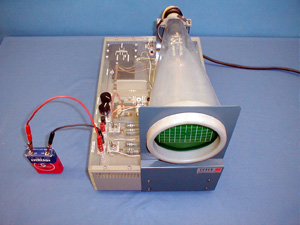Demos: 6B-07 Visible Cathode Ray Tube

As a follow-up to Demo 6B - 02, a cathode ray tube with clear glass sides allows the demonstrator to exhibit the interaction of a magnetic field and an electrostatic field with a moving charge.
Directions: The apparatus is set up for zero deflection of the beam, i.e. the spot will be centered on the screen. To show the effects of the electrostatic field, hook up the 300-V battery to the terminals near the neck of the tube. A potentiometer allows for a variable voltage to be connected to either the x- or y-axis. Vary the voltage to show how the beam is swept across the tube.
Using a magnet, show that by exposing the beam to a magnetic field, the beam can made to move in a manner similar to that in the Demo 6B - 02.
Suggestions for Presentation: First explain how a beam is generated in the tube. Emphasize that it is an electron beam and compare it with the tube used in Demo 6B - 02. In a manner similar to what you did in 6B - 02, show that by moving the magnet around in various ways, the beam can be caused to deflect either up and down or sideways.
Then ask how else a beam might be deflected. Have them consider the effect of an electric field. How might one be produced? Have them predict the direction of deflection, knowing the polarity of the terminals.
Note: Although the electrostatic field causes the beam to be deflected, the deflection of the beam in a commercial CRT is carried out by using crossed magnetic fields, produced by so-called “pancake coils.”
Applications: Commercial cathode-ray tubes.
Last Updated: Nov 30, 2023 11:25 AM